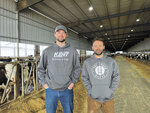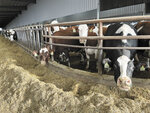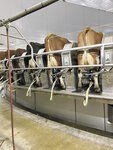


VIBORG, S.D. — Dairy farmers have to take many factors into consideration when choosing their herd sires. Among the foremost of these factors is the level of inbreeding that will result from any particular mating.
One way to get around the inbreeding issue is to mate cows with sires that are of a different breed. The practice of crossbreeding may have downsides, but these can be mitigated by the built-in advantages.
Steve Broersma is the manager of Tri-Cross Dairy, a 5,000-cow operation that was established in 2017 near Viborg.
“Every cow that is being milked at Tri-Cross Dairy is a crossbred,” Broersma said. “Our herd started out with Holstein cows. The Holsteins were bred to Montbéliarde sires, and the resulting heifers were bred to Norwegian Red bulls. We then start the cycle all over by breeding the three-way heifers to Holstein sires.”
Tri-Cross Dairy has a deep history of crossbreeding. One of its co-founders, Wes Bylsma, has been experimenting with crossbreeding on his California dairy operation for nearly 25 years.
“One of the biggest challenges was figuring out the best breeds to use in our crossbreeding system,” Broersma said. “The Holstein and Montbéliarde breeds are both large cattle. Wes eventually settled on using Norwegian Red sires to bring the size down a little. And adding that third breed to the rotation increased the heterosis of our cattle.”
The 5,000 cows at Tri-Cross Dairy are producing an average of 79 pounds of milk per day with 4.4% butterfat and 3.5% protein.
“There is nothing special about the ration that we feed our cows,” Broersma said. “It includes corn silage, alfalfa haylage, soybean meal, distillers grains, cottonseed and a vitamin pack.”
The cows consume 54 pounds of dry matter per head per day.
“The herd is very efficient,” Broersma said. “Our cows are producing an average of 1.5 pounds of milk for every pound of dry matter that they consume.”
Ease of breeding and increased longevity are additional benefits of crossbreeding, according to Jenner Menezes, herd manager at Tri-Cross Dairy.
The dairy has a 50.9% conception rate and a pregnancy rate of 40%.
“We are currently averaging 100 days open with a 60-day voluntary waiting period,” Menezes said. “Most of our breeding is done when the cows naturally come into heat, but we will use ovsynch when it’s needed.”
Crossbred dairy cows have a reputation for being healthier and more vigorous than their straight-bred sisters.
“I can’t remember the last time we had a displaced abomasum,” Menezes said. “We hardly ever have to treat milk fever. Our cows have very little trouble with mastitis. Our hospital pen typically has only eight to 10 head on any given day.”
All of the heifers at Tri-Cross Dairy are synchronized and bred with sexed semen. Cows that fail to conceive after two services are bred to Angus sires. Any cow that does not settle after four services is culled.
“We will vary the number of cows that we breed to Angus bulls depending on how many heifers we have in the pipeline,” Broersma said. “If we need more replacements, we will get m ore aggressive with our use of ovsynch and keep those animals in their normal crossbreeding rotation.”
Longevity is another advantage that can be part of a crossbreeding program.
“Right now, we are averaging 3.6 lactations per animal,” Broersma said. “That number is a bit low at present due, in part, to the large number of first-calf heifers that we recently introduced to the herd.”
The residual value of a crossbred cow is higher than that of a straight-bred animal.
“Our cull cows tend to look beefy and fetch good prices,” Broersma said. “The bull calves are worth somewhere between what a Holstein calf and what a beef calf would bring.”
Tri-Cross Dairy is constantly striving to become more efficient. This means choosing sires that can help boost milk production.
“The No. 1 factor that we look at when choosing our sires is milk production,” Broersma said. “We can focus on production because our cattle don’t have many of the issues that traditional breeds might have, such as feet and leg problems or udder conformity. We already get the best traits from all three of the breeds that we use in our rotation.”
Broersma and Menezes agreed that using a crossbreeding program for a dairy herd involves many more benefits than downsides.
“If you want healthy cows that last a long time, crossbreeding is the way to go,” Broersma said.
Comments
No comments on this item Please log in to comment by clicking here